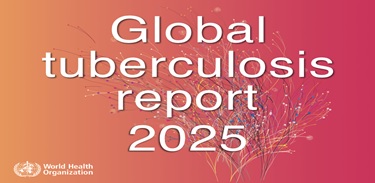10 November, 2025
Global TB Report 2025
Thu 13 Nov, 2025
Context:
- The World Health Organization (WHO) has released the Global Tuberculosis (TB) Report 2025.
Key Highlights of the Report:
- The report presents the global scenario of the epidemiology and control efforts related to tuberculosis (TB).
Global Burden:
- TB Cases: In 2024, an estimated 10.7 million people were affected by TB infection.
- TB Deaths: More than 1.2 million deaths occurred due to TB in the past year, making it the world’s deadliest infectious disease.
- Countries with the Highest Burden: The majority of global TB cases are concentrated in a few countries. In 2024, 67% of global cases came from just eight countries, with India accounting for 25% of total cases, followed by Indonesia, the Philippines, and China.
Progress Rate:
- Global Incidence Rate: Between 2015 and 2024, the global incidence rate (new cases per 100,000 population) declined by 12%.
- Treatment Success Rate: The treatment success rate for drug-sensitive TB was recorded at 88%.
- Drug-Resistant TB (MDR-TB): Although the number of MDR-TB cases showed a slight decline, it remains a major global concern.
India’s Status
Significant Reduction in Cases and Mortality:
| Indicator | 2015 | 2024 | Change | Remark |
| TB Incidence Rate (per 100,000 population) | 237 | 187 | 21% reduction | Nearly double the global reduction rate (12%), among the highest declines globally. |
| TB Mortality Rate (per 100,000 population) | 28 | 21 | Significant decrease | Greater than the global average reduction, reflecting improved treatment quality. |
| Estimated Missing Cases | 1.5 million | Less than 0.1 million | Major success | Unprecedented improvement in diagnosis and reporting of cases. |
Advances in Diagnosis and Treatment:
- Treatment Coverage: Increased from 53% (2015) to 92% (2024). More than 2.618 million TB patients were treated in 2024.
- Treatment Success Rate: Under the TB Mukt Bharat Abhiyan (TB-Free India Campaign), the success rate rose to 90%, surpassing the global rate of 88%.
- Early Detection of DR-TB: Due to extensive coverage of Rifampicin sensitivity testing, the early detection rate of drug-resistant TB (DR-TB) in India is 92%, compared to the global rate of 83%.
Technology and Infrastructure Expansion:
- Active Case Finding (ACF): Under the TB Mukt Bharat Abhiyan, launched in December 2024, innovative technologies and active screening strategies were adopted.
- Over 2.45 million TB patients were identified, including 0.861 million asymptomatic (subclinical) cases.
- Diagnostic Tools: More than 500 AI-equipped handheld chest X-ray units are operational across India, and 1,500 additional machines are being supplied to states/UTs.
- Laboratory Network: Supported by the world’s largest TB lab network, including 9,391 rapid molecular testing (NAAT) facilities.
- Decentralization of Services: TB care services have been extended to the community level through 178,000 Ayushman Arogya Mandirs.
Financial and Social Support:
- Government Funding: The annual budget for the TB program has increased tenfold over the last nine years.
- Nikshay Poshan Yojana (NPY): The nutritional support has been raised from ₹500 to ₹1,000 per month. Since April 2018, more than 13.7 million beneficiaries have received over ₹4,406 crore directly into their bank accounts.
Community Participation (Janbhagidari):
- Over 677,541 individuals and organizations have registered as Nikshay Mitras, distributing more than 4.5 million food kits to TB patients.
- More than 200,000 ‘Mera Bharat’ (My Bharat) volunteers have joined as Nikshay Mitras to provide psychological and community support.
- Customized Treatment: High-risk TB patients are identified based on clinical parameters and co-morbidities and are provided personalized and adaptive care accordingly.
Tuberculosis (TB)
- Tuberculosis (TB) is an infectious disease caused by the Mycobacterium tuberculosis bacterium.
- It primarily affects the lungs (Pulmonary TB) but can also affect other parts of the body, such as bones, kidneys, brain, and spine.
Transmission:
- TB spreads through the air when an infected person coughs, sneezes, or speaks.
- People in close contact with infected individuals are at a higher risk.
- Crowded and poorly ventilated spaces increase the risk of infection.
Symptoms:
- Persistent cough for more than two weeks
- Coughing up blood or sputum
- Loss of weight and loss of appetite
- Night sweats
- Fever and fatigue
Types of TB:
- Pulmonary TB: Affects the lungs.
- Extrapulmonary TB: Affects organs other than the lungs (bones, lymph nodes, brain, kidneys, etc.).
- Latent TB: The bacteria remain inactive in the body without showing symptoms.
- Active TB: Symptoms appear, and the person becomes infectious.
Conclusion:
- The Global TB Report 2025 highlights India’s remarkable progress in reducing TB incidence and mortality through strong government initiatives, community participation, technological innovation, and expanded healthcare coverage.
- India’s efforts—particularly under the TB Mukt Bharat Abhiyan—have positioned it ahead of global targets, bringing the nation closer to achieving the goal of a TB-free India by 2025, five years ahead of the WHO’s global target of 2030.


















